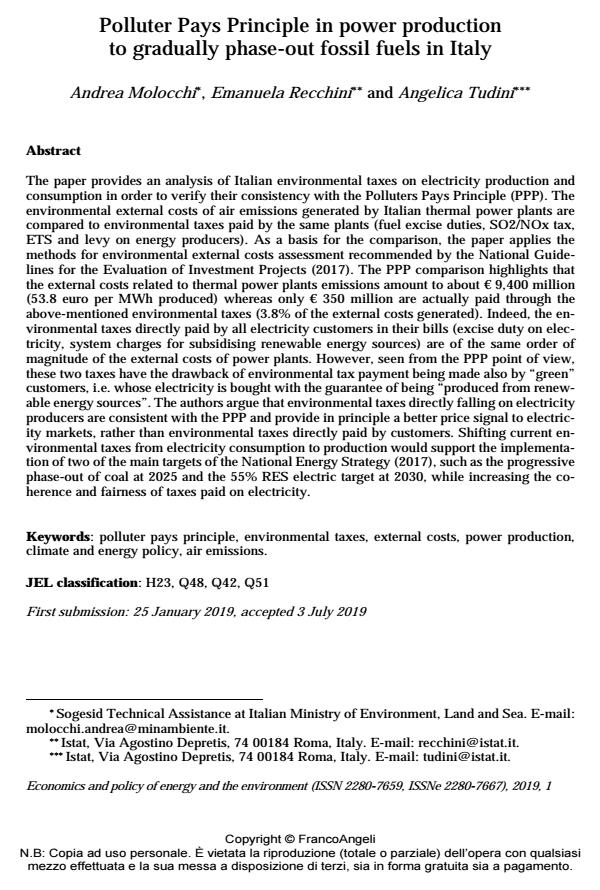Polluter Pays Principle in power production to gradually phase-out fossil fuels in Italy
Titolo Rivista ECONOMICS AND POLICY OF ENERGY AND THE ENVIRONMENT
Autori/Curatori Andrea Molocchi, Emanuela Recchini, Angelica Tudini
Anno di pubblicazione 2019 Fascicolo 2019/1
Lingua Inglese Numero pagine 26 P. 203-228 Dimensione file 186 KB
DOI 10.3280/EFE2019-001013
Il DOI è il codice a barre della proprietà intellettuale: per saperne di più
clicca qui
Qui sotto puoi vedere in anteprima la prima pagina di questo articolo.
Se questo articolo ti interessa, lo puoi acquistare (e scaricare in formato pdf) seguendo le facili indicazioni per acquistare il download credit. Acquista Download Credits per scaricare questo Articolo in formato PDF

FrancoAngeli è membro della Publishers International Linking Association, Inc (PILA)associazione indipendente e non profit per facilitare (attraverso i servizi tecnologici implementati da CrossRef.org) l’accesso degli studiosi ai contenuti digitali nelle pubblicazioni professionali e scientifiche
The paper provides an analysis of Italian environmental taxes on electricity production and consumption in order to verify their consistency with the Polluters Pays Principle (PPP). The environmental external costs of air emissions generated by Italian thermal power plants are compared to environmental taxes paid by the same plants (fuel excise duties, SO2/NOx tax, ETS and levy on energy producers). As a basis for the comparison, the paper applies the methods for environmental external costs assessment recommended by the National Guidelines for the Evaluation of Investment Projects (2017). The PPP comparison highlights that the external costs related to thermal power plants emissions amount to about € 9,400 million (53.8 euro per MWh produced) whereas only € 350 million are actually paid through the above-mentioned environmental taxes (3.8% of the external costs generated). Indeed, the environmental taxes directly paid by all electricity customers in their bills (excise duty on electricity, system charges for subsidising renewable energy sources) are of the same order of magnitude of the external costs of power plants. However, seen from the PPP point of view, these two taxes have the drawback of environmental tax payment being made also by "green" customers, i.e. whose electricity is bought with the guarantee of being "produced from renewable energy sources". The authors argue that environmental taxes directly falling on electricity producers are consistent with the PPP and provide in principle a better price signal to electricity markets, rather than environmental taxes directly paid by customers. Shifting current environmental taxes from electricity consumption to production would support the implementation of two of the main targets of the National Energy Strategy (2017), such as the progressive phase-out of coal at 2025 and the 55% RES electric target at 2030, while increasing the coherence and fairness of taxes paid on electricity.
Parole chiave:Polluter pays principle, environmental taxes, external costs, power production, climate and energy policy, air emissions.
Jel codes:H23, Q48, Q42, Q51
- From production to consumption: An inter-sectoral analysis of air emissions external costs in Italy Andrea Molocchi, in ECONOMICS AND POLICY OF ENERGY AND THE ENVIRONMENT 2/2021 pp.155
DOI: 10.3280/EFE2020-002007
Andrea Molocchi, Emanuela Recchini, Angelica Tudini, Polluter Pays Principle in power production to gradually phase-out fossil fuels in Italy in "ECONOMICS AND POLICY OF ENERGY AND THE ENVIRONMENT" 1/2019, pp 203-228, DOI: 10.3280/EFE2019-001013